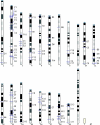Fibroblast-derived induced pluripotent stem cells show no common retroviral vector insertions
- PMID: 19008347
- PMCID: PMC2729671
- DOI: 10.1634/stemcells.2008-0696
Fibroblast-derived induced pluripotent stem cells show no common retroviral vector insertions
Abstract
Several laboratories have reported the reprogramming of mouse and human fibroblasts into pluripotent cells, using retroviruses carrying the Oct4, Sox2, Klf4, and c-Myc transcription factor genes. In these experiments the frequency of reprogramming was lower than 0.1% of the infected cells, raising the possibility that additional events are required to induce reprogramming, such as activation of genes triggered by retroviral insertions. We have therefore determined by ligation-mediated polymerase chain reaction (LM-PCR) the retroviral insertion sites in six induced pluripotent stem (iPS) cell clones derived from mouse fibroblasts. Seventy-nine insertion sites were assigned to a single mouse genome location. Thirty-five of these mapped to gene transcription units, whereas 29 insertions landed within 10 kilobases of transcription start sites. No common insertion site was detected among the iPS clones studied. Moreover, bioinformatics analyses revealed no enrichment of a specific gene function, network, or pathway among genes targeted by retroviral insertions. We conclude that Oct4, Sox2, Klf4, and c-Myc are sufficient to promote fibroblast-to-iPS cell reprogramming and propose that the observed low reprogramming frequencies may have alternative explanations.
Figures



References
-
- Okita K, Ichisaka T, Yamanaka S. Generation of germline-competent induced pluripotent stem cells. Nature. 2007;448:313–317. - PubMed
-
- Wernig M, Meissner A, Foreman R, et al. In vitro reprogramming of fibroblasts into a pluripotent ES-cell-like state. Nature. 2007;448:318–324. - PubMed
-
- Maherali N, Sridharan R, Xie W, et al. Directly reprogrammed fibroblasts show global epigenetic remodeling and widespread tissue contribution. Cell Stem Cell. 2007;1:55–70. - PubMed
-
- Takahashi K, Tanabe K, Ohnuki M, et al. Induction of pluripotent stem cells from adult human fibroblasts by defined factors. Cell. 2007;131:861–872. - PubMed
-
- Yamanaka S. Strategies and new developments in the generation of patient-specific pluripotent stem cells. Cell Stem Cell. 2007;1:39–49. - PubMed
Publication types
MeSH terms
Substances
LinkOut - more resources
Full Text Sources
Other Literature Sources

